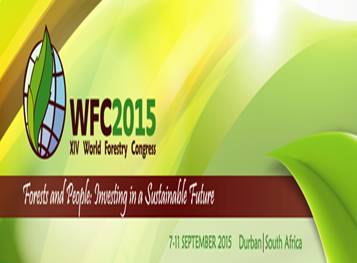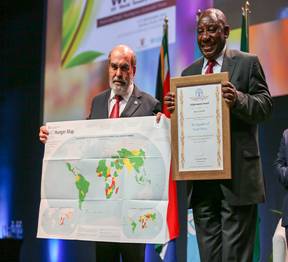A roadcasting from the 14nd World Forestry Congress
9/14/2015 11:29:00 AM
(VACNE) - Just for 5 days, 7-11th September 2015, the 14nd World Forestry Congress held in Durban, South Africa has proposed a new vision to forestry – a new way of thinking and acting – for the future of forests and forestry in sustainable development at all levels.
Do Thi Ngan: an expert of the Vietnam Financial Ministry.
The 14nd World Forestry Congress is the first time held in Africa, although it is the second largest forestry continent in the world (after the South America); and the World Forestry Congress has generally taken place every six years since its inception in 1926, hosted by Rome.
This Congress is certainly crucial as the world will be entering a new development era with the adoption of the post-2015 sustainable development goals.
|

|

|
|
At the event, José Graziano da Silva, Director-General, FAO, presents Deputy President Cyril Ramaphosa, South Africa, an achievement award for reducing hunger within the country. Photo credit: iisd.ca.
|
The biggest global event for forestry sector
The five-day congress, hosted by the Republic of South Africa, under supporting by the Food and Agriculture Organization of the UN (FAO), with the central theme is “Forests and People: Investing in a Sustainable Future”.
The Congress program was professionally and culturally rewarded, with: the High Level Dialogue on the Global Forest Agenda (on the first day of the Congress), 5 plenary sessions, 107 sessions, 178 side events, a Forests and People photo contest, and a TREEHOUSING International Wood Design Competition. These were covered by 6 sub-theme dialogues, supported by 1.094 papers presented, and hundreds speech delivers.
Not only following by millions more globally online followers, there were over 5.000 inclusive of attendees from all countries, regions and sectors, whether they belong to a government organization, NGO, private company, scientific or professional body, a forestry society, or simply have a personal interest in attending. Remarkably, a social media team of over 275 people world-wide was reporting from the Congress.
Meaningful to “the future we want”
Although the five-day event is short comparing to its mission; but the impact of its outcome is obviously crucial - to sustaining the world!
The Congress has successfully produced its three expected outcome documents – on: a new way of thinking and acting – for the future of forests and forestry in sustainable development at all levels; roles of forests in implementing the Sustainable Development Goals (SDGs); and a preparation for the 21st Conference of the Parties to the United Nations Framework Convention on Climate Change in Paris at the end of this year.
In terms of benefit to the world of 9 billion people, the event is fruitful as re-emphasizing that forests are essential to life on our planet, to mitigating and adapting to climate change, ensuring adequate supply of fresh water, enhancing biodiversity and providing sustainable incomes and livelihoods, including food security.
The event is crucially significant as the “skin“ of our “Mother Earth” has turned to the “tipping point” – forests face unprecedented and unrelenting pressures. As was stated in the closing day:
“Investing in forests and forestry is investment in people and their livelihoods, especially the rural poor, youth and women. In turn, this is investment in sustainable development and in achieving the Sustainable Development Goals by 2030”, said by Deputy President of South Africa Cyril Ramaphosa in the Closing Plenary of the event.
To draw messages of the Congress, three key aspects of forests and forestry were featured strongly in the future of forests: improving food security and livelihoods, integrating forests and other land uses, and making forests a solution to climate change.
Apparently, the 5 serious themes were deeply addressed, including: forests for socioeconomic development and food security, building resilient with forests, intergrating forests and other land uses, encouraging product innovation and sustainable trade, monitoring forests for better decision-making, and improving governance by building capacity.
It was differently with a view that forest management is a cross-cutting issue, and not only about keeping the trees, rather – it is about mutual existences between trees and living things, including people.
Particularly, three comprehensive professional reports brought to the event: the Global Forest Resources Assessment 2015 - product of research conducted in 234 countries and territories across the world (presented by FAO), new global satellite observations of tree cover reductions in 2014 (released by Global Forest Watch), and an article specially describing over 400.000 field plots from national forest inventories that were used to count all of the world’s trees (published by the
Nature). These reports will certainly being “hand book” references to the world as well as countries, organizations, and individuals in practicing sustain the “world we want” now and in the future.
Lượt xem : 3132